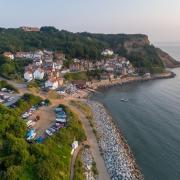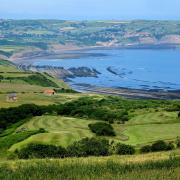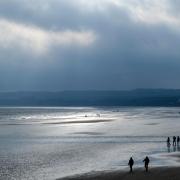Get your teeth into a coastal adventure hunting down Yorkshire's dastardly dragons...
Of all the menagerie of fabulous beasts, the dragon looms particularly large in British folklore and mythology.
When St George, whose saint’s day we celebrate on 23 April, slew his scaly adversary, he was symbolically conquering the powers of darkness in the name of Christianity.
Even today, the dragon is a potent symbol – when we call something ‘draconian’, or extremely harsh, we’re invoking the name of an exceptionally severe 7th century Athenian lawmaker, Draco – but his name was Latin for dragon.
And it’s not for nothing that JK Rowling chose the name for Harry Potter’s arch enemy, Draco Malfoy (and perhaps no coincidence that the boy wizard himself bears the name of one of England’s great heroes: 'Cry ‘God for Harry, England and St George!’').
This month, we’re taking you on a quest to find the dragons of the Yorkshire coast – some friendly, some not so much.
A very unfriendly dragon once tyrannised the people of Filey, but it didn’t count on how enterprising Yorkshire folk are. There are different variations of the tale, but the unifying thread is that the dragon had a weakness for gooey cake such as parkin – could it really have been all that fearsome? We picture it having a nice cup of tea, its pinky claw raised genteelly in the air…
Anyway, we digress. It was that sweet dragon’s tooth which caused its downfall – the townspeople fed it so much parkin that it tumbled into the sea and drowned, its spine turning into the famous rocky peninsula known as the Brigg.

The most famous ‘dragon’ associated with Whitby is, of course, Count Dracula (Dracul is Romanian for devil, but also derives from the Latin draco), but we’re sure you’ve heard enough about him to last an undead lifetime. We want you to meet another fearsome beast which terrorised Whitby – the Whitby Wyrm (‘wyrm’ or ‘worm’ being an alternative name for a dragon, probably most famously as in County Durham’s Lambton Worm).
This dragon was disturbed from its sleep by the construction of Whitby Abbey, and was so angry that it attempted to destroy the town. But the Whitby people (or perhaps the Abbey’s Benedictine monks, depending on which version you read) were as fierce in protecting their hometown as those in Filey, and banished the monster into the sea, from whence it still returns once every seven years at a full moon, trying to claw away the cliff below the Abbey in an attempt to make it fall into the sea.
We wish we could give you a heads up on his next visit, but funnily enough, that information doesn’t seem to be on Tripadvisor…

You’ll easily spot the park’s best-known dragons – the red and green ones that patrol the lake. They may look ferocious, but they’re actually pussycats underneath the teeth, equipped with pedals so that families can take a trip round the central island in safety.
Hunt around a little and you’ll find a distinctly dozy-looking dragon hidden in the bushes (clue: he’s near the bridge and the boating pond).

For more information on events and attractions across the Yorkshire Coast #placeofsurprise and the North York Moors this month, visit discoveryorkshirecoast.com or call the Tourism Bureau on 01723 383636.
*Yes, dragons have their very own collective noun – in fact, they have quite a few, including flight, wing, doom, weyr, blaze and thunder. So, er – what’s the collective noun for a group of collective nouns?
Myth, or reality – the sea dragons of the Yorkshire Coast
Dragons are, of course, real. Sea dragons, that is – or, to give them their full and proper name, plesiosaurs, carnivorous reptiles that lived in the Jurassic seas off our coast some 180 million years ago.
You can still see their remains in two of the coast’s favourite museums. At Scarborough’s Rotunda, you’ll find the Speeton plesiosaur, a 4.5m long fossilised skeleton (it’s missing its head, unfortunately) found by an amateur fossil hunter near Filey back in 2001.
And at Whitby Museum, amidst a treasure trove of over 7,000 fossils large and small, you can meet the precursor of one of today’s most powerful reptiles, the crocodile. The teleosaur in the Whitby collection was found in 1824 and is believed to be the finest example of the species yet discovered.
And we’ll leave you with a more recent encounter. In 1934 Filey coastguard Wilkinson Herbert was walking on the beach when he met a terrifying sea creature – his story was reported by no less an authority than The Daily Telegraph, which quoted him as saying: 'I heard a growling like a dozen dogs ahead; walking nearer I switched on my torch and was confronted by a huge neck, six yards in front of me, rearing up 8ft. high!
'Huge eyes like saucers, glaring at me, the creature’s mouth was a foot wide and neck would be a yard around. The monster appeared as startled as I was.
'It was a most gruesome and thrilling experience. I have seen big animals abroad, but nothing like this.'
Perhaps dragons do still exist…



























